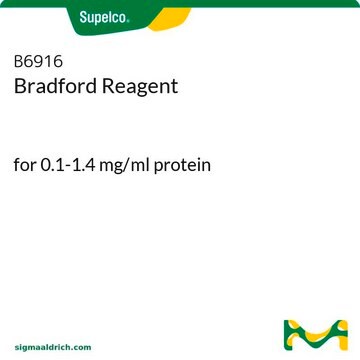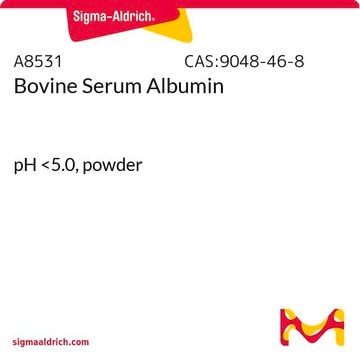1.15444
Coomassie Brilliant blue G 250 (C.I. 42655)
for electrophoresis
Sinónimos:
Coomassie Brilliant blue G 250 (C.I. 42655), Acid blue 90, Brilliant Blue G, Cyanine G, Polar Blue G, SERVA BLUE G, protein gel stain
Seleccione un Tamaño
60,80 €
Seleccione un Tamaño
About This Item
60,80 €
Productos recomendados
Nivel de calidad
potencia
>5000 mg/kg LD50, oral (Rat)
técnicas
protein staining: suitable
pH
6.4 (20 °C, 10 g/L in H2O)
solubilidad
40 g/L
densidad aparente
520 kg/m3
temp. de almacenamiento
no temp limit
cadena SMILES
[Na+].[S](=O)(=O)([O-])c1cc(ccc1)CN(CC)c2cc(c(cc2)[C+](c5c(cc(cc5)N(CC)Cc6cc(ccc6)[S](=O)(=O)[O-])C)c3ccc(cc3)Nc4ccc(cc4)OCC)C
InChI
1S/C47H49N3O7S2.Na/c1-6-49(31-35-11-9-13-43(29-35)58(51,52)53)40-21-25-45(33(4)27-40)47(37-15-17-38(18-16-37)48-39-19-23-42(24-20-39)57-8-3)46-26-22-41(28-34(46)5)50(7-2)32-36-12-10-14-44(30-36)59(54,55)56;/h9-30,48H,6-8,31-32H2,1-5H3,(H-,51,52,53,54,55,56);/q;+1/p-1
Clave InChI
CMGWKYXJIYYESN-UHFFFAOYSA-M
Descripción general
Aplicación
Nota de análisis
Absorption maximum λmax. (buffer pH 7.0): 577 - 584 nm
Spec. Absorptivity A 1%/1cm (λmax; 0.01 g/l; buffer pH 7.0; calc. on dried substance): 450 - 570
TLC-Test: passes test
Loss on drying (110 °C): ≤ 8 %
Suitability for electrophoresis: passes test
Información legal
Código de clase de almacenamiento
11 - Combustible Solids
Clase de riesgo para el agua (WGK)
WGK 3
Punto de inflamabilidad (°F)
Not applicable
Punto de inflamabilidad (°C)
Not applicable
Certificados de análisis (COA)
Busque Certificados de análisis (COA) introduciendo el número de lote del producto. Los números de lote se encuentran en la etiqueta del producto después de las palabras «Lot» o «Batch»
¿Ya tiene este producto?
Encuentre la documentación para los productos que ha comprado recientemente en la Biblioteca de documentos.
Los clientes también vieron
Artículos
Identify causes and remedies for SDS-PAGE sample preparation challenges and optimize electrophoresis conditions.
Filtros activos
Nuestro equipo de científicos tiene experiencia en todas las áreas de investigación: Ciencias de la vida, Ciencia de los materiales, Síntesis química, Cromatografía, Analítica y muchas otras.
Póngase en contacto con el Servicio técnico







